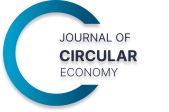Effective Communication of Underlying Research Philosophies Can Improve Circular Economy Research in the Foundation Industries
Abstract
The drive to address environmental challenges in the Foundation Industries is leading to an ever greater, and more diverse, volume of Circular Economy related research. Despite increased expectations for research to achieve positive impact, authors do not always have the tools to effectively communicate to readers what their study’s underlying research philosophy is, regarding how knowledge will lead to impact. We propose terminology for authors to concisely communicate their approaches to knowledge generation (fundamental or applied) and route to impact (reformative or transformative). Reformative research does not seek to fundamentally disrupt or change the prevailing (or conventional) production systems, whereas transformative research does. We provide recommendations for how authors can effectively communicate their study’s research philosophy in an appropriate level of detail.
DOI: https://doi.org/10.55845/CPEO1326
References
Bocken, N. M. P., de Pauw, I., Bakker, C., & van der Grinten, B. (2016). Product design and business model strategies for a circular economy. Journal of Industrial and Production Engineering, 33(5). https://doi.org/10.1080/21681015.2016.1172124
Dosso, M., Martin, B. R., & Moncada-Paternò-Castello, P. (2018). Towards evidence-based industrial research and innovation policy†. Science and Public Policy, 45(2), 143–150. https://doi.org/10.1093/scipol/scx073
FAO. (2024). Global forest products facts and figures 2023. https://doi.org/10.4060/cd3650en
Hammond, G. P. (2022). The UK industrial decarbonisation strategy revisited. Proceedings of the Institution of Civil Engineers – Energy, 175(1), 30–44. https://doi.org/10.1680/jener.21.00056
Levi, P. G., & Cullen, J. M. (2018). Mapping Global Flows of Chemicals: From Fossil Fuel Feedstocks to Chemical Products. Environmental Science & Technology, 52(4), 1725–1734. https://doi.org/10.1021/acs.est.7b04573
OECD. (2015). Frascati Manual 2015: Guidelines for Collecting and Reporting Data on Research and Experimental Development.
Olsson, J. A., Hafez, H., Miller, S. A., & Scrivener, K. L. (2025). Greenhouse Gas Emissions and Decarbonization Potential of Global Fired Clay Brick Production. Environmental Science & Technology, 59(4), 1909–1920. https://doi.org/10.1021/acs.est.4c08994
Reike, D., Vermeulen, W. J. V., & Witjes, S. (2018). The circular economy: New or Refurbished as CE 3.0? — Exploring Controversies in the Conceptualization of the Circular Economy through a Focus on History and Resource Value Retention Options. Resources, Conservation and Recycling, 135. https://doi.org/10.1016/j.resconrec.2017.08.027
Scrivener, K., Ben Haha, M., Juilland, P., & Levy, C. (2023). Research needs for cementitious building materials with focus on Europe. RILEM Technical Letters, 7, 220–252. https://doi.org/10.21809/rilemtechlett.2022.165
UKRI. (2021). Transforming Foundation Industries challenge. Summary report: Innovation Readiness in UK Foundation Industries. https://www.ukri.org/wp-content/uploads/2021/03/UKRI-080321-TransformingFoundationIndustriesChallenge.pdf
USGS. (2024). Mineral Commodity Summaries 2024. https://doi.org/10.3133/mcs2024
Westbroek, C. D., Bitting, J., Craglia, M., Azevedo, J. M. C., & Cullen, J. M. (2021). Global material flow analysis of glass: From raw materials to end of life. Journal of Industrial Ecology, 25(2), 333–343. https://doi.org/https://doi.org/10.1111/jiec.13112
World Steel Association. (2024). World Steel in Figures 2024. https://worldsteel.org/data/world-steel-in-figures-2024
How to Cite This Article
Marsh, A.T.M., & Hafez, H. (2025). Effective Communication of Underlying Research Philosophies Can Improve Circular Economy Research in the Foundation Industries. Journal of Circular Economy, 3(1). https://doi.org/10.55845/CPEO1326
Copyright
Open Access: This article is licensed under a Creative Commons Attribution 4.0 International License, which permits use, sharing, adaptation, distribution and reproduction in any medium or format, as long as you give appropriate credit to the original author(s) and the source, provide a link to the Creative Commons licence, and indicate if changes were made. The images or other third-party material in this article are included in the article’s Creative Commons licence, unless indicated otherwise in a credit line to the material. If material is not included in the article’s Creative Commons licence and your intended use is not permitted by statutory regulation or exceeds the permitted use, you will need to obtain permission directly from the copyright holder. To view a copy of this licence, visit http://creativecommons.org/licenses/by/4.0/.
Author Notes
Alastair T.M. Marsh[1][2]*, Hisham Hafez[1]
- [1]School of Civil Engineering, University of Leeds, Leeds, LS2 9JT, United Kingdom
- [2]Laboratory of Construction Materials, École Polytechnique Fédérale de Lausanne, Lausanne 1015, Switzerland
Published Details: Received:29.10.2024 / Accepted: 22.01.2025 / Published: 18.02.2025
